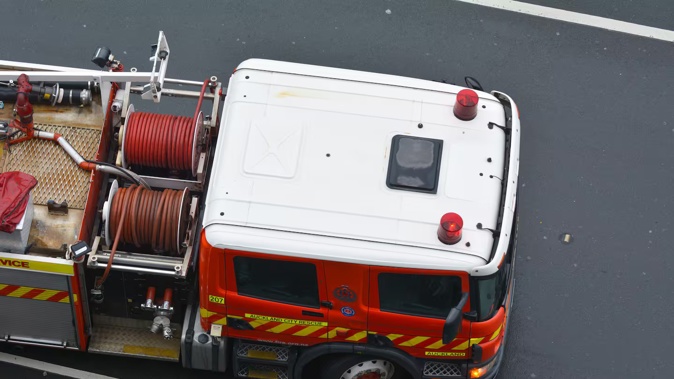
By Phil Pennington of RNZ
The country’s newest fire engines cannot be used at rescues because they are too small to fit all the lifesaving gear they need to carry.
Firefighters say managers have even talked about cutting holes in them to make room for the gear.
Fire and Emergency New Zealand said it was “not ideal”, but it was working on a solution. In the meantime, delivery of the engines has been disrupted.
One firefighter called it “ridiculous”, but “not unexpected”.
Fire and Emergency NZ spent millions of dollars and five years shipping the 28 medium-sized fire trucks – called a Type 3, the fleet workhorse – to Britain to get them fitted out.
They have now returned to New Zealand, with stations with old trucks that keep breaking down expecting them.
But two trial runs at packing gear on them last month did not go well.
“So we were having to stow gear on top of other gear and it was just jamming up all the lockers,” said Hamilton firefighter Jamie Marshall-Carter.
“We were trying to get to other important rescue gear and we were unable to get it out because we were having to offload things on top.”
They pulled the plug on the two-day test after just four hours.
Senior firefighter Adam Wright witnessed the same thing in Auckland on September 9.
Photos show the floor around the new truck covered in gear.
“There were things like our post-fire decontamination gear, our Stokes basket rescue stretcher, the standpipes that we need to get the water out of the fire hydrants into the truck, none of that could fit,” said Wright.
“By the end of that morning, we had probably 20% of our firefighting and rescue gear sitting on the floor without a home for it.”
An entry control board to keep track of firefighters in burning buildings – or the ramps used to drive over hoses – also did not fit, he said.
Fire and Emergency NZ’s new deputy national commander Megan Stiffler ordered the Hamilton test when the one at Mt Wellington station failed.
“Ideally, would this have happened – no. But this is a positive story in that we’re working with the crews on how we can best fit these evolving needs of the rescue teams,” she said.
The two firefighters – both union representatives at the tests – said the trucks would be a lot better than existing trucks if used just to pump water, as a large number of fire trucks were.
But a Fire and Emergency NZ schedule showed at least 11 of the 28 trucks were meant to be rescue tenders, equipped with a broad range of gear for fire rescues, car crashes and storms.
The firefighters were in no doubt. Wright circulated an email after his test saying: “After consultation with all party’s [sic] present it was collectively agreed and recommended that the current Angloco-Man appliance is not suitable for use as a rescue tender in Auckland.”
Marshall-Carter’s team in Hamilton has already told Fire and Emergency NZ they will not use the trucks as they are.
At the test, they pushed back at suggestions from managers who also witnessed the gear piling up on the floor.
“They just wanted to seem to cut holes into areas to fit pieces of equipment, into the bodywork as such.
“As a brigade we just felt like... you’re starting to compromise the structural integrity.”
Stiffler has been in the role of deputy national commander for just a few months, coming from a top fire job in New South Wales.
She gave RNZ an interview, when Fire and Emergency NZ often only provides written statements.
She said it was not about blame.
“Our project team, which included firefighters, agreed on standard equipment for the build.
“What we have is a few of our stations have very specific rescue needs – an example would be snow chains in Dunedin – that not everyone needs. And they weren’t actually captured anywhere on inventory lists.”
So the list that went to Britain was smaller than what firefighters needed.
“I don’t know why these items weren’t included in that inventory - as you said, I wasn’t here. What I can do though, is now that I know the problem needs solving, is work with my crews to find that solution,” she said.
Marshall-Carter, who has worked at stations from Napier to Auckland, was certain that no brigade anywhere could make their essential rescue gear fit.
He and Wright also both rejected the claim that firefighters were consulted.
“There’s basically been little to no operational involvement in the design of these trucks,” said Wright.
“It’s very perplexing that we have built over 20 of them and delivered them to New Zealand before we’ve actually tried to fit equipment on them and make sure it all fits.
“While it’s ridiculous, it’s not unexpected.”
Fire and Emergency NZ and the Professional Firefighters’ Union have been locked in months-long negotiations for a new collective agreement.
The union has been running an online campaign with a diary of truck breakdowns. “Dunedin’s front-line truck: Broken,” was one entry. Another said a foam truck in Wellington had just one-tenth of the original capacity in a jerry-rigged system
Stiffler said it was about finding a fix.
“What we’re going to do is work with those local areas and understand how their inventory’s grown and then find a solution that best suits that place.”
It was not clear why local needs were not determined before, during the several years the trucks sat in New Zealand waiting for a fit-out in the UK.
Marshall-Carter said they tried as hard as they could to make the gear fit. They had waited a long time for the trucks and he had had high hopes the new truck would go straight to busy Chartwell station as scheduled.
“If they don’t get a new appliance, [it] just rolls on and on and on and no one gets the updated trucks.
“Brigades that get less calls, they’re going to have these 20, 25-year-old trucks just sitting in their station, just waiting.”
A Fire and Emergency NZ schedule shows Christchurch brigades were meant to get three new trucks last month.
Local union president Aaron McKay said they were “extremely disappointed” with Fire and Emergency NZ.
“Our temperamental fleet ... won’t be updated as soon as we would prefer.”
Wright said it was not as if any of the gear that did not fit on was actually “extra”.
He had representatives from five rescue tender stations across Auckland – trainers, group management, fleet and equipment teams, and logistics personnel – all watching the test.
“We did try multiple options. And you’re right, some equipment could come off to fit the other equipment that was on the floor, but none of the equipment was optional.
“It was all critical firefighting and rescue equipment.
“So we were stuck.”
Stiffler later said the trucks were “in the process of transitioning ownership” from the manufacturers to Fire and Emergency NZ, which would involve “locker build” on each vehicle.
The scheduled dates provided to RNZ earlier were arrival dates in New Zealand. “We are about a week behind schedule.”
-RNZ
Take your Radio, Podcasts and Music with you









